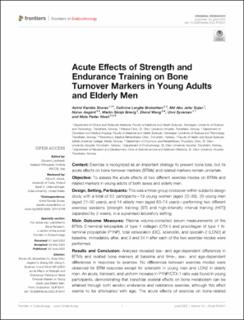| dc.contributor.author | Stunes, Astrid Kamilla | |
| dc.contributor.author | Brobakken, Cathrine Langlie | |
| dc.contributor.author | Sujan, Md Abu Jafar | |
| dc.contributor.author | Aagård, Norun | |
| dc.contributor.author | Brevig, Martin Siksjø | |
| dc.contributor.author | Wang, Eivind | |
| dc.contributor.author | Syversen, Unni | |
| dc.contributor.author | Mosti, Mats Peder | |
| dc.date.accessioned | 2023-01-31T15:52:52Z | |
| dc.date.available | 2023-01-31T15:52:52Z | |
| dc.date.created | 2022-10-12T09:32:13Z | |
| dc.date.issued | 2022 | |
| dc.identifier.citation | Frontiers in Endocrinology. 2022, 13 (June), 1-14. | en_US |
| dc.identifier.issn | 1664-2392 | |
| dc.identifier.uri | https://hdl.handle.net/11250/3047508 | |
| dc.description.abstract | Context: Exercise is recognized as an important strategy to prevent bone loss, but its acute effects on bone turnover markers (BTMs) and related markers remain uncertain. Objective: To assess the acute effects of two different exercise modes on BTMs and related markers in young adults of both sexes and elderly men. Design, Setting, Participants: This was a three-group crossover within-subjects design study with a total of 53 participants—19 young women (aged 22–30), 20 young men (aged 21–30 years), and 14 elderly men (aged 63–74 years)—performing two different exercise sessions [strength training (ST) and high-intensity interval training (HIIT)] separated by 2 weeks, in a supervised laboratory setting. Main Outcome Measures: Plasma volume-corrected serum measurements of the BTMs C-terminal telopeptide of type 1 collagen (CTX-I) and procollagen of type 1 N-terminal propeptide (P1NP), total osteocalcin (OC), sclerostin, and lipocalin-2 (LCN2) at baseline, immediately after, and 3 and 24 h after each of the two exercise modes were performed. Results and Conclusion: Analyses revealed sex- and age-dependent differences in BTMs and related bone markers at baseline and time-, sex-, and age-dependent differences in response to exercise. No differences between exercise modes were observed for BTM response except for sclerostin in young men and LCN2 in elderly men. An acute, transient, and uniform increase in P1NP/CTX-1 ratio was found in young participants, demonstrating that beneficial skeletal effects on bone metabolism can be attained through both aerobic endurance and resistance exercise, although this effect seems to be attenuated with age. The acute effects of exercise on bone-related biomarkers were generally blunted after 24 h, suggesting that persistent alterations following prolonged exercise interventions should be assessed at later time points. | en_US |
| dc.description.abstract | Acute effects of strength and endurance training on bone turnover markers in young adults and elderly men | en_US |
| dc.language.iso | eng | en_US |
| dc.publisher | Frontiers Media | en_US |
| dc.relation.uri | https://doi.org/10.3389/fendo.2022.915241 | |
| dc.rights | Navngivelse 4.0 Internasjonal | * |
| dc.rights.uri | http://creativecommons.org/licenses/by/4.0/deed.no | * |
| dc.title | Acute effects of strength and endurance training on bone turnover markers in young adults and elderly men | en_US |
| dc.title.alternative | Acute effects of strength and endurance training on bone turnover markers in young adults and elderly men | en_US |
| dc.type | Peer reviewed | en_US |
| dc.type | Journal article | en_US |
| dc.description.version | publishedVersion | en_US |
| dc.source.pagenumber | 1-14 | en_US |
| dc.source.volume | 13 | en_US |
| dc.source.journal | Frontiers in Endocrinology | en_US |
| dc.source.issue | June | en_US |
| dc.identifier.doi | 10.3389/fendo.2022.915241 | |
| dc.identifier.cristin | 2060716 | |
| cristin.ispublished | true | |
| cristin.fulltext | original | |
| cristin.qualitycode | 1 | |

